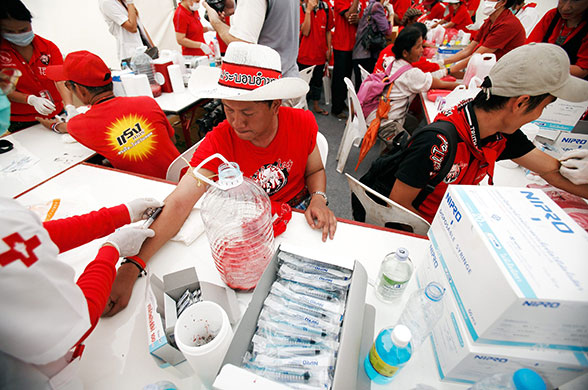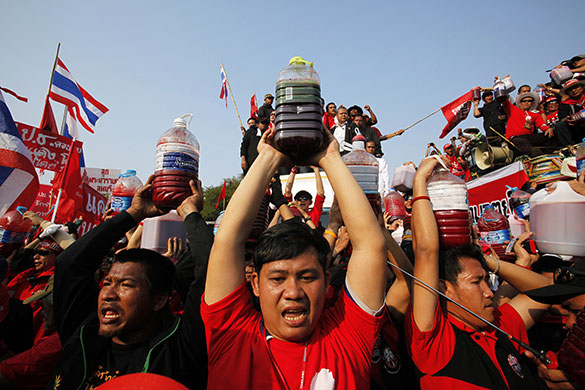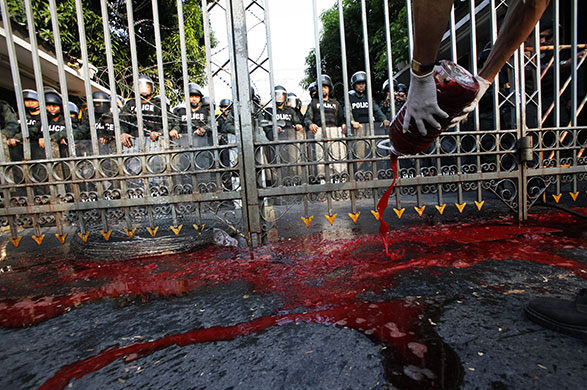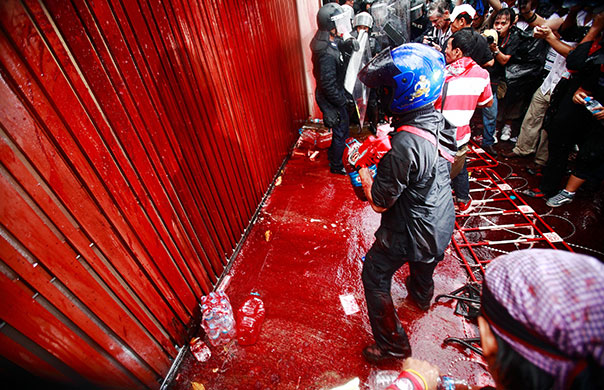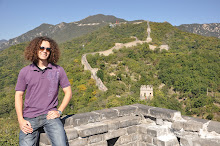
“Where has this cuisine been all my life? Why am I in my mid-twenties and just now discovering this amazing food?” These were my thoughts after eating several dishes from the “Thai Cottage” restaurant in Houston. After I sampled the chicken yellow curry I was hooked. It seemed to carry the perfect balance of sweetness from the coconut milk with the wonderfully spicy, aromatic, and exotic flavor from the curry. It was topped with potatoes and carrots and served with steamed rice. What more could I want? I could have literally eaten that dish every day of the year.
The only other Thai dishes I had before coming to Thailand were Pad Thai and chicken satay. My experience in the U.S. was that the Pad Thai was hit or miss, either really good or just OK. The chicken satay with peanut sauce was generally good anywhere and the curry dishes were always flavorful, tasty, and spicy (depending on how you much you dared to try, I typically asked for medium spiciness).
Naturally, when I arrived in Thailand a little over a year ago, I was very excited to get a taste of actual authentic Thai cuisine. One of my first meals included a chicken satay with peanut sauce that blew away anything I had ever had in the U.S. I also tried out Tom Yum Goong for the first time and immediately fell in love with it. This brown soup had all kinds of unidentifiable cut-up herbs and spices in it plus pieces of shrimp, fish, squid, and muscles. It had a perfect balance of flavors - sweetness, sourness, spiciness, and saltiness. Even though it was spicy, the spiciness surprisingly complimented the flavor rather than overpower it. I was left with a tingling hot mouth that felt pleasant which curiously didn't need to be urgently extinguished as is the case with most spicy food. I felt a warm glowing happiness and my taste buds were in bliss. This is when I knew that Thai food was going to be my new favorite cuisine.
Over the weeks and months during my stay here, I have tried many more Thai dishes, most of which I had never heard of before. I've also tried the different tropical fruits including pomelo, jackfruit, custard apple, mangosteen, longan, and durian. I learned how to eat Thai-style with a spoon rather than a fork (spoon in the right hand for eating, fork in the left hand for cutting and scooping food into the spoon) and to eat noodle soup with a spoon in the left hand with a pair of chopsticks in the right hand. The toddlers and kids have it right, eating with a spoon is so much easier!
After a year of eating all this excellent food and telling myself that I should learn how to cook it, I finally took the leap and signed up for a 5 day course at The Somphong Thai cooking school. It is located at the end of an alley off a busy street (Silom road). The school is actually the home of an old Thai lady, Somphong, in a traditional outdoor (and covered) kitchen. Along the main wall are a series of gas burners with woks at the ready. The other wall serves as an open air pantry and display of various fruits, vegetables, herbs, and sauces. In the middle of the kitchen is a large table for food preparation. During the course of the week, I learned that this area is not only where the cooking classes are held but it serves as the hangout spot and dining room for the family itself. I couldn't have picked a more authentic place to learn how to cook Thai food.
 The Silom Market
The Silom MarketThis is how my first day went.
The school is managed and run by Somphong's niece, Koy. The class begins with a trip to the local market. The open-air market is nothing more than a side street crammed with food vendors all along both sides. Koy tells us to be careful of the passing motorcyles and tuk-tuks and leads us to a small walkway that surprisingly opens up to a huge covered market. Half the market is dedicated to freshly cut meat where both live and freshly cut fish are on display for sale. With wicker baskets in hand, we follow Koy to a coconut grinding stall. We see how shaved coconut is made from fresh coconuts (grinding machine), and how coconut cream and coconut milk is made from the shaved coconuts (mechanical press). She explains how to make an order and how much it should cost.

Curry Pastes and bottled sauces
 Koy explaining the various peppers
Koy explaining the various peppers
A look around Silom Market
We continue through the market stopping at various points where Koy talks about the various foodstuff there. I learn many things such as: all the curry pastes can be bought (easier to buy than to make by hand, but we will learn how to do it the hard way), shrimp paste is made by marinating a salt mixture with baby shrimp for a year (no wonder it stinks so much!), there are at least a half dozen types of eggplant, at least a dozen different types of pepper (the smallest ones are the hottest), and 3 types of basil in Thailand. Throughout our tour Koy buys and fills our baskets with our ingredients for the day. We make our way back to the school to let the cooking commence.
 Our classroom - A traditional Thai style open-air kitchen
Our classroom - A traditional Thai style open-air kitchen
We are equipped with a bright purple apron, a matching purple napkin, a wooden cutting block, and a rather large knife. Koy hands us our recipe books and begins the class explaining how to make curry paste. Using a mortal and pestle, we hand grind a mixture of ingredients (mostly chilies, herbs, and spices) until it becomes a smooth paste. The work is difficult but we are rewarded with an excellent green curry paste. She shows us how to cut various vegetables and gives us pre-measured containers of seasonings (sugar, salt, fish sauce, coconut milk, etc). With all our ingredients ready, we go to the wok and cook away as she tells us what to add and how to long to cook. Within minutes, we have completed our first dish, a great looking bowl of chicken green curry. We all go to the back room (thankfully air-conditioned) and try out our first dish. It's the best green curry I've ever had! I may be biased but, really, it was the best green curry I ever had. And I can say that I cooked it – from scratch!
 Koy is demonstrating how to cut various vegetables
Koy is demonstrating how to cut various vegetables

Woks in action!
The rest of the day, and indeed, the rest of the week followed the same pattern. We prepared, cut, and mixed all of the ingredients first, then we went to the woks and slowly added everything until another culinary creation was completed. Cooking Thai food was, dare I say, actually pretty easy. Looking over the entire process, the most difficult part is collecting all the not-so-common ingredients from the market (I'm sure this is especially more difficult in the US – you'd probably have to go to a special Asian store for some of the ingredients). Once you have everything, the prep time is fast (cutting, chopping, mixing) and the cooking time is even faster.
 Ingredients to make Green Curry Paste
Ingredients to make Green Curry Paste
Thai cuisine is famous for being spicy. Most people who like spicy food will come to love Thai food. I was never a fanatic about spicy food, but after tasting the local food I've become a lover of spicy Thai food. The secret is not the type, amount, or strength of chilies, but rather the balance of spiciness with flavor. I had great joy learning about this aspect of Thai food during the course. Before preparing a new dish, Koy would explain the specific flavors we were trying to achieve then tell us about each ingredient and how it contributed to the overall balance. For example, Koy would explain that sweet sticky rice with mangoes should taste sweet
and a salty (it's not a Thai style dessert if it's not a little salty). Thus, we add coconut milk, sugar, and salt. What pleased me was that all dishes usually had 2, 3, or 4 simple flavors delicately mixed to create an overall masterpiece. Such is the case with Tom Yum Goong. The end result should taste sweet, sour, spicy and salty. For this combination we add (among other ingredients) appropriate amounts palm sugar (sweet), lemon juice (sour), chilies (spicy), and fish sauce (salty). By the end of the course I had a pretty good idea of what to add to achieve a desired flavor.
We also learned some simple presentation techniques. This included making a rose from the skin of a tomato, learning how to wrap chicken in Pandanus leaves (imagine doing origami with banana leaves), garnishing plates with various flowers, and topping dishes with hand-made sauces.
 My lovely rose made from a tomato
My lovely rose made from a tomatoI've finished the course and learned how to make 25 Thai dishes. I'm still amazed at how easy it is to cook such wonderfully delicious, yet simple dishes. After successfully cooking several dishes at home after the course, I can confidently say that I cook Thai food! :)
 All in a day's work
All in a day's workEven though it may be 100 degrees outside, I can understand why people in Thailand will still eat sweatingly spicy food. Thai food makes you happy. It tastes so good, and it's been shown that the capsaicin in chili peppers causes the release of endorphins – the happy chemical. Despite the problems and poverty in Thailand, the people, for the most part, continue to be happy. I think their food has a lot to do with why Thailand is known as “the land of smiles.”
My Culinary Creations!
(Click to see a slideshow of my dishes)





